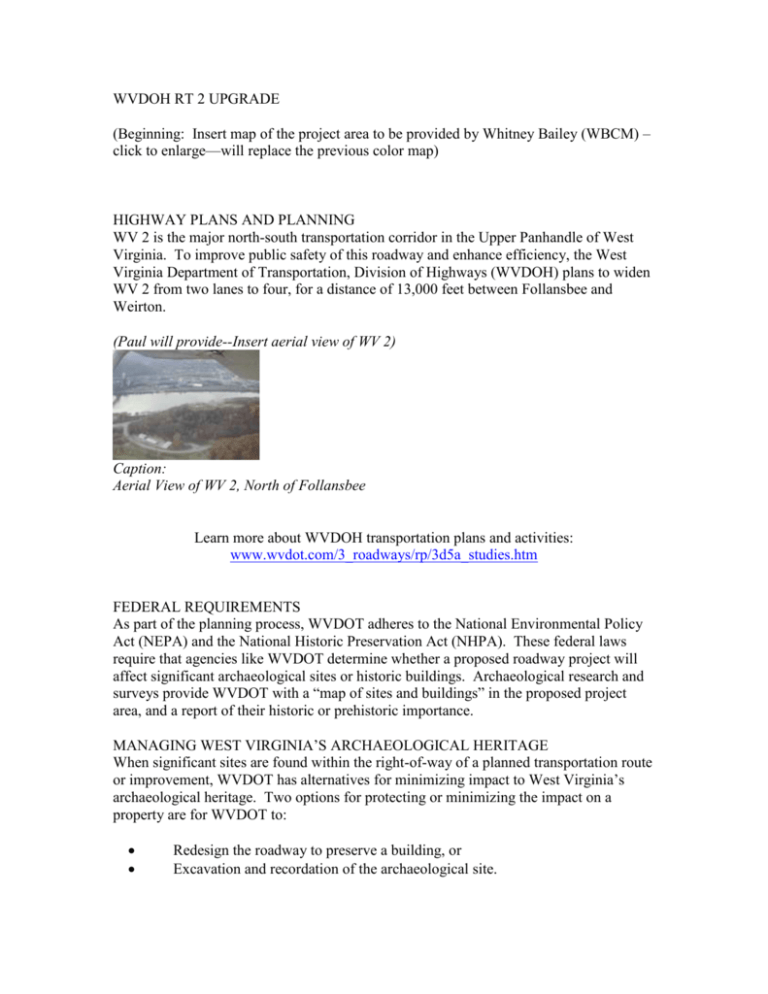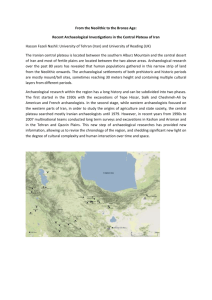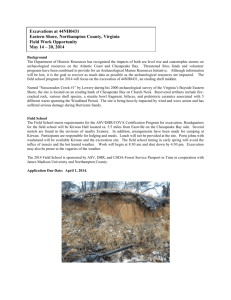wvdoh rt 2 upgrade - West Virginia Division of Culture and History
advertisement

WVDOH RT 2 UPGRADE (Beginning: Insert map of the project area to be provided by Whitney Bailey (WBCM) – click to enlarge—will replace the previous color map) HIGHWAY PLANS AND PLANNING WV 2 is the major north-south transportation corridor in the Upper Panhandle of West Virginia. To improve public safety of this roadway and enhance efficiency, the West Virginia Department of Transportation, Division of Highways (WVDOH) plans to widen WV 2 from two lanes to four, for a distance of 13,000 feet between Follansbee and Weirton. (Paul will provide--Insert aerial view of WV 2) Caption: Aerial View of WV 2, North of Follansbee Learn more about WVDOH transportation plans and activities: www.wvdot.com/3_roadways/rp/3d5a_studies.htm FEDERAL REQUIREMENTS As part of the planning process, WVDOT adheres to the National Environmental Policy Act (NEPA) and the National Historic Preservation Act (NHPA). These federal laws require that agencies like WVDOT determine whether a proposed roadway project will affect significant archaeological sites or historic buildings. Archaeological research and surveys provide WVDOT with a “map of sites and buildings” in the proposed project area, and a report of their historic or prehistoric importance. MANAGING WEST VIRGINIA’S ARCHAEOLOGICAL HERITAGE When significant sites are found within the right-of-way of a planned transportation route or improvement, WVDOT has alternatives for minimizing impact to West Virginia’s archaeological heritage. Two options for protecting or minimizing the impact on a property are for WVDOT to: Redesign the roadway to preserve a building, or Excavation and recordation of the archaeological site. THE IMPORTANCE OF ARCHAEOLOGY AND DISCOVERY In 1999, archaeological survey and testing found two prehistoric sites of great significance on a ridgetop in the WV 2 project right-of-way—East Steubenville (Site Br31) and Highland Hills (Site Br60). Both of these ancient Native American campsites contained vestiges of the Panhandle Archaic cultural complex. Clearly, these sites could unveil new information about the little-known Panhandle Archaic people who inhabited northern West Virginia nearly 4,000 years ago. RECORDING THE PAST The unusually high level of historical significance at the East Steubenville and Highland Hills sites made them eligible for listing on the National Register of Historic Places. Because both sites would be impacted by construction of the WV 2 upgrade, WVDOT and its consultants developed a Data Recovery Plan to excavate the archaeological remains, and to interpret and report on these discoveries. DATA RECOVERY EXCAVATIONS In 1999-2000, archaeological excavations recovered a wealth of artifacts, especially at the East Steubenville Site. Midway through fieldwork, archaeologists made an unexpected discovery of human burials. To assure appropriate treatment of the human remains, consultations were held between the Federal Highways Administration, WVDOT, the WV State Historic Preservation Office (WVSHPO), GAI, and “interested parties” that included Native American groups. (Insert photo) Caption: Meeting on-site with interested parties CONSULTATION AND AGREEMENT Meetings and discussions led to a Memorandum of Agreement (MOA) signed by the FHWA, WVSHPO, WVDOT, the Turtle Clan of the Onondaga Nation, and the Council for West Virginia Archaeology. This Agreement balanced scientific and Native American concerns by requiring osteological study of the skeletal remains before reburial. THE REBURIAL CEREMONY At the Highland Hills Memorial Gardens, just north of the East Steubenville Site, a Reburial Ceremony was held on October 6, 2001. Chief Waterman of the Onondaga Nation directed the ceremonial reburial of six Panhandle Archaic Native Americans. Bundled in buckskin, their remains were returned to earth near a granite monument. (Insert photos—slides from Paul) “Chief with Monument” photo? Caption: Chief Waterman of the Onondaga presides over Reburial Ceremony “Ceremonial Photo with participants” photo. Caption: Reburial ceremony participants place soil in graves October 2001 GAI awarded prestigious WVDOH “2001 Engineering Excellence Award” for Native American Burial Site Relocation (Insert scanned Certificate) Ryan: Could you find some “creative” graphic way to provide the Acknowledgements (below)? They’re sort of “apart” from the flow of text in this section, yet belong on this web page. ACKNOWLEDGEMENTS In addition to WVDOT, GAI, and WBCM staff, many organizations and individuals contributed to the success of the archaeological investigations of the East Steubenville site. Henry Compton, Federal Highway Administration (West Virginia), guided consultation on the appropriate treatment of human remains. Susan Pierce and Joanna Wilson of the West Virginia Division of Culture and History identified the appropriate parties to consult and provided the viewpoint of West Virginia's State Historic Preservation Office. The West Virginia Archaeological Council, the West Virginia Archaeological Society, the Eastern Band of the Cherokee Nation, and other Native American groups, all presented valuable opinions that helped the FHWA find a middle ground for treatment of the human remains. Alan Fisher and Doug Coleman of Cornerstone Family Services, Inc. granted property access for conducting data recovery excavations, and developed the reburial location at Highland Hills Memorial Gardens. The staff of Highland Hills facilitated archeological excavations and assisted in reburial logistics. Chief Waterman of the Turtle Clan of the Onondaga Nation presided over the reburial ceremony, bringing Native Americans and others together in a common purpose.





